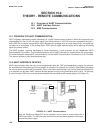
130
MODEL 3081 pH/ORP SECTION 16.0
GLOSSARY
Fault A fault is a system disabling condition. Measurement data displayed during a fault
condition are probably in error and should be regarded with great suspicion. The
Model 3081 pH/ORP transmitter displays fault messages to aid in trouble-shooting.
Filling solution The electrolyte solution inside an electrode is called the filling solution. The
buffered electrolyte solution inside a glass electrode is usually called the internal
filling solution. The solution inside the reference electrode is usually called the
external filling solution, or, simply, the filling solution. In many industrial reference
electrodes, the filling solution is not a liquid but is a semi-solid gel. Glass imped-
ance. The overall resistance of the glass membrane to the flow of current. Glass
impedance is a strong function of temperature. Impedance increases as temper-
ature decreases. Temperature corrected glass impedance is a valuable diagnos-
tic tool. Abnormally low impedance implies a cracked or broken glass membrane.
High impedance suggests that the electrode is nearing the end of its life.
Glass electrode pH measuring electrodes are often called glass electrodes. The electrode is a
piece of glass tubing that has a pH-sensitive glass membrane blown onto the end.
The tube is filled with a buffered solution of potassium chloride. A silver wire coat-
ed with silver chloride contacts the fill solution, and the silver wire is connected to
the electrode lead wire. The entire electrode is sealed."Glass" refers to the pH-
sensitive glass membrane in the sensor.
Glass membrane The glass membrane is the pH-sensitive glass piece blown onto the bottom of the
glass tube that forms the body of the glass electrode. The pH sensitive glass is
usually a bulb, but it can be flat.
Ground Ground usually refers to either earth ground or a common. Earth ground is the
earth or a conducting body serving in place of the earth. A common is a point in
a circuit to which other voltages are compared. The meaning intended is usually
clear from the context.
Ground loop A ground loop exists when a circuit is connected to earth ground at two or more
points. The potential of the earth varies from point to point, so multiple connec-
tions to ground cause currents to flow. If the current flows through a signal carry-
ing wire, the result is a noisy, offset signal. In a typical process measurement, the
pH sensor is connected through the process liquid to earth ground. If the circuit-
ry in the pH transmitter becomes connected to a second earth ground, current will
flow through the reference electrode. A voltage, proportional to the current and the
electrode resistance, develops across the reference electrode. Because the volt-
age is in series with the other potentials in the cell, the ground loop current caus-
es the pH reading to be substantially different from the expected value. pH read-
ings affected by ground loops are often noisy as well.
Half reaction A half reaction shows the gain or loss of electrons by a chemical species. The half
reaction for a silver-silver chloride reference electrode is
AgCl (s) + e
-
= Ag (s) + Cl
-
In the half reaction, a silver ion in the silver chloride crystal gains an electron and
becomes a silver atom. The electron consumed by the silver ion comes from a
second half reaction occurring elsewhere in the system.
HART HART is an acronym for highway addressable remote transducer. HART is a dig-
ital communication system in which digital signals are superimposed on the 4-20
mA output signal from the transmitter. Using a HART communicator connected
across the output, the user can view process measurements and can calibrate
and program the transmitter.


















